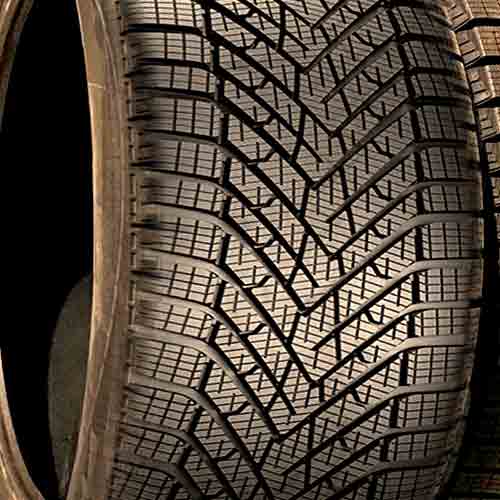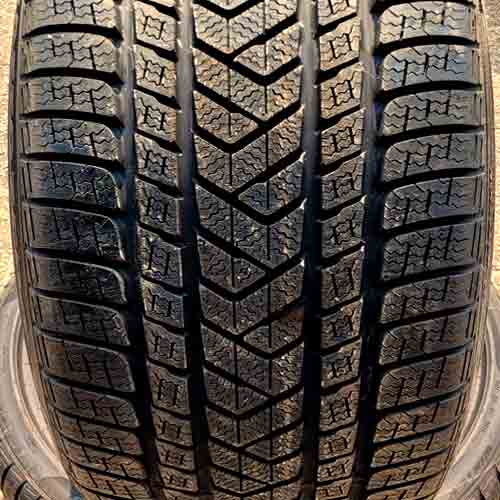Both Pirelli Scorpion Winter and the Winter 2 are the superheroes of the winter tire domain, where the updated model shows-off even better abilities to combat the toughest icy conditions. Let’s check out the differences of both tires.

Table of Contents
Key Takeaway
The Pirelli Scorpion Winter 2 takes the lead when it comes to:
- Superior traction on icy terrain due to its unique tread design and aggressive siping pattern.
- Extended tread life attributed to its lighter structure, reducing wear.
- Enhanced performance in both dry and wet conditions, particularly in terms of directional grip, handling, and resistance to hydroplaning.
- Better fuel efficiency due to reduced rolling resistance.
- Greater overall ride comfort due to noise reduction and a smoother ride.
On the other side, the Pirelli Scorpion Winter:
- Faces challenges under icy conditions because of larger tread voids and fewer notches.
- Tends to wear faster because of its heavier weight and larger tread voids.
- Although it exhibits excellent snow performance due to its aggressive tread pattern and spacious structures, it falls short in comparison to the Winter 2 in other conditions.
- Is less fuel-efficient because of greater rolling resistance values.
- Provides a softer ride due to its rubber compound but is outperformed in overall comfort by the Winter 2.
Ice Performance
In terms of performance on icy surfaces, the Pirelli Scorpion Winter 2 excels, showcasing its unique and sophisticated tread design that features a combination of different-sized angled slits and snow vices, setting a high standard in the tire industry.

This tire’s performance is further amplified by its aggressive siping pattern, which enhances braking distances and vehicle handling by providing additional biting edges, thereby improving its traction on icy terrain.
On the other hand, the Pirelli Scorpion Winter struggles to perform under icy conditions due to its larger tread voids and fewer notches.
Its primary tread area struggles to maintain a firm grip on compacted ice, while the absence of multi-directional sipes reduces its overall performance on ice.
While the tire does offer good enough inter-connectivity of the lugs to enhance traction on highly icy surfaces, it just can’t offer the same amount of grip as its successor.
And it makes sense since the Winter 2 is so much more biting in comparison, so it offers better overall ice performance, where its excels in all, directional ice grip/lateral traction, and steering response.
Tread Life
The lifespan of a tire’s tread is significantly influenced by the tire’s weight and its tread design.
The Pirelli Scorpion Winter 2 stands out for its excellent tread life, largely attributed to its lighter structure, which reduces the force exerted on the rubber during road contact, thus prolonging tread wear.
On the contrary, its predecessor carries a heavier weight and features a design with larger voids.
This means, there’s an increased weight in the first place, and since that weight is distributed over a smaller surface area of rubber, each lug ends up getting more stress.
This stress causes the tread to rub against the road/surface with greater friction, thereby accelerating tread wear.
As a result, the Pirelli Scorpion Winter tends to wear faster compared to its counterpart.
Dry Traction
In dry conditions, the Pirelli Scorpion Winter 2 performs better in terms of directional grip and handling, which are the two primary aspects of dry performance.
The tire’s directional grip, largely determined by the central tread area, offers a more streamlined lug design with the Pirelli Scorpion Winter 2, providing consistent road contact for improved braking and acceleration.

If you consider it’s tread pattern again, you can see how its more streamlined in comparison, and has fewer voids, allowing for greater connectivity with the road, resulting its grip.
And with a more streamlined directional pattern, it shifts its weight towards shoulders better, as the tire corners.
This effective weight shifting allows for faster steering response, where the tire’s lighter weight in the first place is already helping the overall steering dynamics a lot.
In contrast, the Pirelli Scorpion Winter, despite its wider grooves, carries additional weight that may induce lug movement during cornering, diminishing steering feedback and negatively affecting handling.
So overall the newer tire is better in terms of overall dry performance as well.
Snow Performance
Both tires exhibit excellent performance in snowy conditions, but closer testing with them, reveal some unexpected results.
Now interestingly, although the Pirelli Scorpion Winter is a older tire here, it still has a slight advantage due to its aggressive directional tread pattern, amplified by lugs with spacious structures that effortlessly capture loose, fluffy snow particles.
Moreover, the tire’s numerous snow vices and interlocking grooves aid in trapping snow, providing better ground contact, given that snow adheres more readily to itself than to rubber.
In comparison, the newer tire’s design is more compact and lacks an interlocking groove structure, restricting its ability to gather as much snow as its competitor, thereby slightly compromising its snow performance.
Though the tire does offer better snow acceleration in comparison, where it’s proper V shaped lugs act as snow shovels, throwing snow backwards generating forward motion.
But yes, overall scores, from my tests, are better on the predecessor, the Scorpion Winter.
Wet Traction
The ability of a tire to maintain a firm grip on wet surfaces is largely influenced by the rubber compound it uses and its tread design. These two factors significantly impact the overall wet performance, which consists of two primary components – wet grip and hydroplaning resistance.
Let’s check them both.
Wet Gripping
Similar to dry conditions, wet grip depends on the amount of rubber that makes contact with the road. However, water forms a barrier that prevents full tread-to-surface contact, necessitating the removal of this water layer.
This removal is facilitated by the tire’s grooves and sipes. While grooves channel out most of the water, providing resistance to hydroplaning (discussed further down), sipes handle the remaining water particles at a micro level.
In the case of the Pirelli Scorpion Winter 2, greater number of sipes, and its design offering more multi-angled notches provide superior grip.
These biters act as water contains on wet roads, where they suck up water, and clear the road relatively, so that rubber can grip on.
This way, water does not come in the middle, and the tire does not float. This is actually the very definition of hydroplaning.
Resistance to Hydroplaning
Now both tires are great here, whey they both provide decent hydroplaning (or tire’s floating) resistance, displaying remarkable float speeds in both straight and curved water tests. (Float speed refers to a tire’s speed over standing water).
But still, as this resistance comes form the effectiveness of grooves, the overall scores are better on the newer tire.
I mean even though the predecessor is more voided up, the Winter 2 has better inter-connectivity of its grooves, where, if you consider its tread again, you’d note that all it’s V shaped grooves are joined up with each other, with the help of slanted longitudinal slits.
This allows for more water displacement in all directions, contributing to overall wet performance too. As more water leaving via grooves, means less would be there for biters to suck up.
So the Pirelli Scorpion 2 offers better wet traction and resistance to hydroplaning, compared to its predecessor.
Fuel Efficiency
Fuel efficiency in tires is intrinsically linked to rolling resistance, which is affected by traction and the tire’s weight.
This is because heavier tires, for example, with larger tread voids tend to have more flex during cornering, braking, or acceleration, requiring more energy.
And since this characteristic is notably seen in the Pirelli Scorpion Winter 2, you get to see slightly better mpg readings on this tire.
In contrast, the predecessor, with its less streamlined and aligned ribs, creates greater rolling resistance values.
And so the Winter lacks in overall fuel efficiency compared to Winter 2.
Ride Comfort
A tire’s comfortability is a balance of several factors, including road noise, vibration dampening, tread pattern, and sidewall design.
Pirelli Scorpion Winter 2 has a minor advantage in noise reduction due to its compact tread design, which minimizes noise generation by reducing air circulation within the voids.
Furthermore, its lighter weight ensures quicker response times and a smoother ride.
However, Pirelli Scorpion Winter offers superior comfort due to its softer rubber compound, absorbing road irregularities more effectively.
But since the bumps are more controlled on the newer tire, the Scorpion Winter 2 ends up getting greater overall scores, in terms of ride comfort.
Concluding Words
So overall, the Pirelli Scorpion Winter 2 outperforms its predecessor in several areas.
On icy terrains, it showcases superior grip and handling due to its unique tread design and aggressive siping pattern.
In terms of tread life, the Winter 2’s lighter structure significantly prolongs wear compared to the heavier, stress-prone predecessor.
In dry conditions, it offers enhanced grip, handling, and steering dynamics.
And although the older Scorpion Winter edges out the successor in snow performance with its aggressive directional tread pattern, the Winter 2 rebounds in wet conditions with improved grip and hydroplaning resistance.
Fuel efficiency is also superior in the Winter 2, thanks to its reduced rolling resistance.
Lastly, while both tires offer comfort, the Winter 2 narrowly surpasses its predecessor in noise reduction and ride smoothness, despite the older model’s softer rubber compound that absorbs road irregularities better.